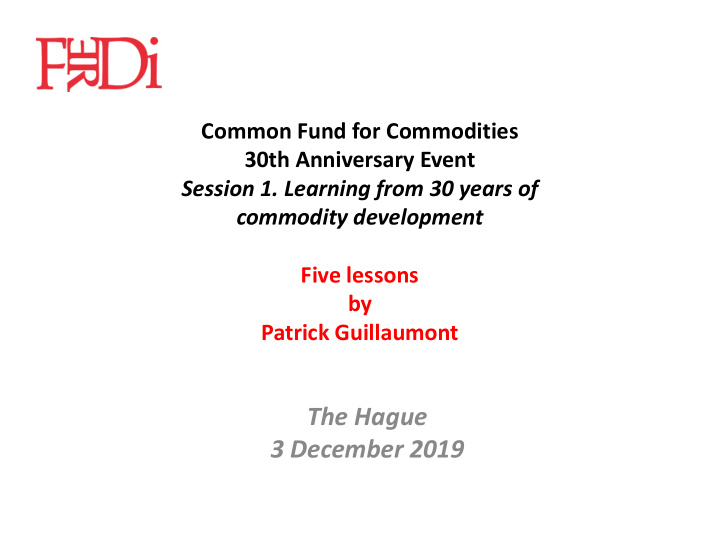



Common Fund for Commodities 30th Anniversary Event Session 1. Learning from 30 years of commodity development Five lessons by Patrick Guillaumont The Hague 3 December 2019
Learning from 30 years…and from the 15 years before • CFC operational in 1989, from an idea launched at the Nairobi UNCTAD IV in 1976, • This Conference and the IPC, following the first oil shock and a strong commodity boom, were a deep misunderstanding, raising the hope that high prices of commodities could be maintained by a common decision • An ideological overshooting on the long term rigid price levels (regardless to market trends) drew the attention out of a realistic address to price instability • Then when the commodity prices decreased, followed by a debt crisis in CDCs, leading to adjustment policies, a reverse ideological overshooting occurred against any commodity price stabilisation policy • The history of the years before the 30 last ones definitely illustrates that the major problem to be addressed did not result from long term market price trends to which public and private agents are led to adapt, but from the instability to which they are less prepared to adapt… • Moreover the history of the 30 last years evidences that the vulnerability of CDCs should be addressed in a more general framework than what results from international price instability and by new approaches • In that perspective we can draw 5 lessons from 30 years of commodity development
1st lesson: Price stabilisation cannot ignore the market long term trends • This hold both for domestic and international policies, because long term trends result from the evolution of tastes, resource discoveries and technology • International price stabilisation policies are feasible only if they refer and progressively adjust to these long term trends: feasible stabilisation can only be a stabilisation around the trend • By the same way domestic price or income stabilisation policies cannot be delinked from the evolution of international prices • Nevertheless such policies are still needed as far as there is a strong evidence that instability in commodity price and export receipts lowers the progress of productivity and economic growth, and undermines the quality of governance and the socio-political stability • Needed, but according to a new approach…
2d lesson: Positive shocks should be managed as transitory, not permanent • The main issue revealed by instability is the macro-management of positive shocks (due to asymmetry of reactions to positive and negative ) • A large body of literature has shown that difficulties encountered in the reversal of commodity export receipts mainly came from that the export booms have been managed as if they were permanent and not transitory, while they most often did appear transitory: irreversible public expenditures (increase in number and salaries of public servants), large size of public investments of rather low productivity, etc • Has this lesson be heard? Not sure, in particular in countries dependent of mineral and oil exports, as revealed by the experience of numerous such countries in the last decade • This mismanagement is particular at risk when the state exerts a high control of the commodity sector, while deep needs are rapidly to be met, and when the state is fragile, or simply facing elections
3d lesson: Past failure of public management of commodities should not lead to give up any public policy • From that marketing boards and caisses de stabilisation were most often mismanaged, it did not follow that there was no need of stable prices and security, for economic as well as social reasons • « Casser la caisse stab » was not a policy • Paradoxically the need of of security has been better met with respect to natural shocks than to price shocks • Innovative schemes have been experimented, such as weather indexed insurance, credit facilities, flexible financial products…with some public support • In all cases, these innovative schemes, implemented at a rather micro- level, have involved a strong participation of the commodity small producers… • …and they have transformed the approach of price stabilisation itself
4th lesson: Resource or commodity curse is a popular warning, not a fate dictating policy • Various kinds of asymmetric « perverse effects» of commodity booms: loss of competitiveness in the non booming sector (dutch disease), excess indebtness, rigid expansion of public sector, corruption… • Generating the idea that there is a resource or commodity « curse », linked either to commodity price increase or to resource discovery • In fact, there is no « curse », but a risk of bad management: the curse theory is a warning about this risk, not a reason for neglecting the role of commodities in development, by a wrongly oriented diversification • For oil and minerals, the issue is the use of the rent, not their refusal. • For agricultural commodities, need to avoid their marginalisation (and a risk of a new « urban bias ») by developing « forward linkages » supported by contracts within « value chains » (a commodity based diversification)
5th lesson: Considering the commodity dependence in the broader framework of addressing vulnerabilities • While commodities remain an important source of income, the dependency on commodities should be considered in the broad framework of the multi-dimensionnal vulnerabilities • It is not only a dependency with respect to foreign markets and international prices • It is also a vulnerability with respect to climate and climate change, In particular for agricultural commodities, • It is also a vulnerability with respect to bad governance or a socio- political vulnerability, in particular for mineral commodities • The 3 kinds of vulnerability (3 reverse faces of sustainability) should and can be addressed, both at the macro and micro levels, so that commodities become friendly to development • CFC is precisely trying to do so at a micro and efficient level. • A long way since 1976 and many lessons learned!
Thanks
Recommend
More recommend